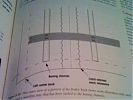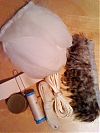Apologies but this is a bit of a “brain dump” post as I’m understandably a bit frazzled right now, with the BurdaStyle book deadline looming on top of wedding planning and everything else I seem to list every time I post (ahh, just thinking about it is starting to stress me out, sorry!).
So I haven’t done much tangible work on my gown since I last updated because I’ve been focusing on getting the BS book dress done since it has a more immediate deadline, but I’ve been doing lots of mental sewing on the gown. Which, you’ll remember, is half the battle for me. So I took an evening out to read (really read and digest!) through “Bridal Couture” by Susan Khalje and the OOP Palmer/Pletsch “Bridal Gowns–How to Make the Wedding Dress of Your Dreams” book (the former being way way more useful than the latter IMHO). I placed copious amounts of Post-It notes sticking out the edges at places I want to refer back to later.
I’m also really glad I ended up taking that PR online Underlining class a few months ago now!! Though I just looked to see if I could link to the Underlining class somehow, and I noticed Susan Khalje herself is teaching a “Wedding Gowns 101” class starting Aug 15. If it were a few months earlier, I’d have jumped all over it, but you need time to devote to the classes most evenings and I’ll need all the time I can get to work on my gown!
After reading through the two books I had everything mostly straight in my head about this dress, but the boning placement still puzzled me because my pattern doesn’t have any obvious vertical seaming to place the boning along, and all three examples in Bridal Couture had some sort of princess seaming. Luckily for me, it was easily solved on the PR messageboard and by this Susan Khalje article, so I’ve got a full gameplan in my head now for the dress!
Construction plan of attack
- Second muslin with boning and waist stay
- Remove boning and waist stay (save for the dress), unpick seams and use muslin as the pattern pieces. Cut out pieces in the (very well-pressed!) vintage silk, with 1″ seam allowances at zipper opening.
- Cut out pieces in (prewashed) white flannel underlining.
- Possible pleating?
- Stack underlining and silk and underline/thread-baste by hand with ivory silk thread (no dye to possibly come off). transfer marks onto underlining.
- Possible piping?
- Assemble pieces together along thread lines with the sewing machine.
- Press, clip, and hand-tack seam allowances to flannel underlining.
- Create organza boning channels (including basque front support) and hand-tack to flannel underlining.
- Attach bra fasteners to ends of waist stay grosgrain ribbon (This is my own special stroke of genius! Pre-padded and already adjustable!). Handstitch waist stay to seam allowances and underlining, aligning bottom edge to waist line.
- Stitch twill tape along neckline, clip and fold neckline and armscye edges in. Hand tack neckline and armscye seam allowances to flannel underlining.
- Cut out pieces in lining fabric and assemble. Stitch buttonholes in lining near zipper opening for waist stay. Clip and fold in neckline and armscye edges
- Handstitch lining edges to dress edges. Prickstitch near the openings.
- Attach skirt to bodice, preserving original piping and basque front.
- Install salvaged original vintage metal zipper in side opening (lapped and prick stitched). Install organza boning channel to one side of zipper tape (thanks, Olga!).
- Insert boning into all channels and secure bottom edges.
- Hand-tack lining to waist seam and zipper tape.
- Attach bra strap retainers (possibly) and hanging loops
- Start work on fascinator and veil and honeymoon lingerie…
And I have, err, almost exactly two months left to do it in.
So I figured the first thing to do with my plan is gather together all the supplies I need so I’m not wasting precious time during the construction waiting on internet delivery or using up a whole afternoon to travel into the West End to buy in person.
Supplies bought/ordered:
- White flannel for underlining. 2m @ £2.20/m from Chawla’s
- Light ivory silk organza for boning channels. 1m @ £7.95/m from cheapfabrics
- Pale blue silk crepe for lining. 1m @ £8.95/m from cheapfabrics
- 1m 25mm wide grosgrain ribbon for waist stay, 78p at MacCulloch & Wallis
- 2m twill tape for neckline stabilising, £1.50 at MacCulloch & Wallis
- 2m ivory satin rat-tail for possible piping, £1.08 at MacCulloch & Wallis
- 0.5m white goose feathers for fascinator, £15.50 at MacCulloch & Wallis
- 10cm of brown coque feathers for fascinator, £1.84 at MacCulloch & Wallis
- Ivory silk Gutermann thread for hand stitching, £2.33 at MacCulloch & Wallis
- Beeswax for handstitching, £2.75 at MacCulloch & Wallis (though this Threads article says to stay away from beeswax when sewing white fabrics?)
- To buy: spiral steel boning and end caps, £?? total from The Sewing Chest
- To buy: bra back fastener for waist stay, 70p from The Sewing Chest
- Total (thus far): £47.78 ($73.63 or €56.80)
A field trip!
Yesterday I went to the Maison Martin Margiela exhibit at Somerset House with Neighbour Helen. I only knew the briefest amount about the design collective but Helen utterly adores them so I thought it’d be a fun play-date and diversion (and an excuse to hit up MacCulloch & Wallis afterwards, as seen above). The exhibit was surprisingly large and great for getting ideas and creative inspiration, though not necessarily in the “I’d so wear that!” copyable range!
General inspiration notes: Leather trousers with mid-leg seams, and a mini skirt inserted in the central panels. Plain knit dresses printed with photos of vintage ballgowns and summer frocks. Thick paint on fabric that crackkles more with each wear. Surreal shoulder shapes (I so want to try that Burda mag Balmain ripoff now!). Very creative refashioning of belts, gloves, and sandals into cage-type dresses and waistcoats. Creative draping – pull a hem up onto a shoulder and show a lacy layer underneath. Play with oversized proportion in buttons and knit gauge.
(Sorry no photos were allowed inside so it’s just my brain dump!)
It was a pretty big exhibit over two floors and the way things were set up really matched the creativity of the designs. In particular they made very good use of video and light and sound and I think we ended up spending over an hour in there geeking out. For £6 entry I think it was well worth it, so if you’re in London, I’d definitely recommend it (it’s on until 5 Sept).


